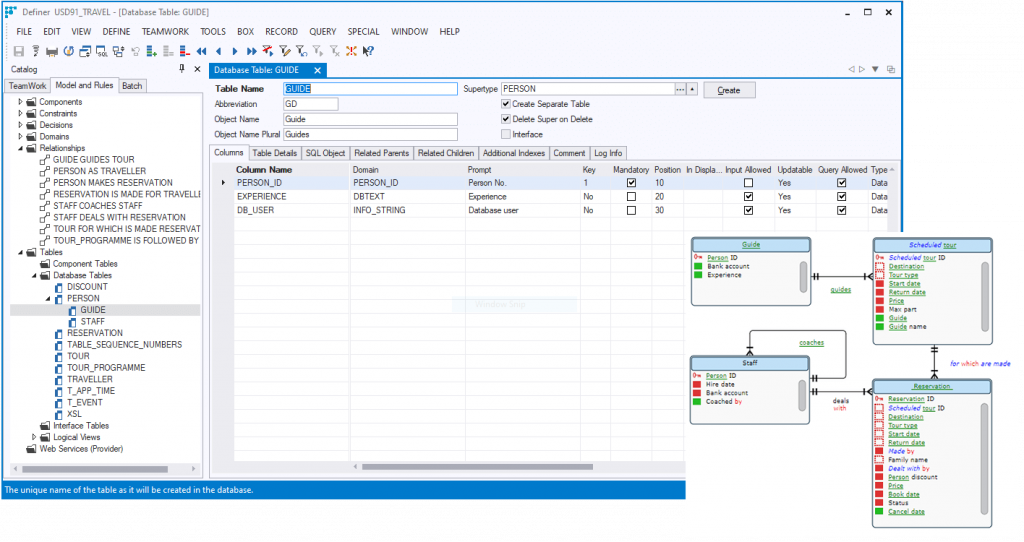You probably recognize the following situation. You have quality software running in your organization. Unique applications that are often tailored on all manner of specialist tasks. Great. But how do you ensure optimal, permanent integration of all those applications combined? And how do you make sure you quickly and effectively meet new expectations of the organization?
Wouldn’t it be nice if everything was integrated, so you could quickly switch between the different applications or add and renew features rapidly? Wouldn’t it be nice if data only needed to be entered once from now on and that you can quickly add and renew extra functionality!?
You could say that front-end applications often lack proper integration with back-end systems. It’s IT that sometimes gets in its way. By continuing to build separate applications, it is quite a job to keep everything up to date and maintain control.
Many people think the only solutions are a lot of programming work or large expenditure for external hours. Don’t worry, though, because there’s another great solution: combining low-code development with the power of business rules.
Challenges for IT Managers
As an IT manager, you have several essential tasks, namely: planning, directing and coordinating activities related to data management, information systems, systems analysis and computer programming. And all this as efficiently as possible.

This often results in too little time for real innovation or improvement of your systems. Things that the organization is waiting for but can’t get to because everything has to be kept running.
Business processes are changing faster than IT can keep up with. Many IT systems then become isolated islands, which are cut off from the rest of the company’s systems. That’s why it’s often very time-consuming to change any defined processes.
With business rules-driven low-code, you quickly (re)build very stable and easy-to-maintain core applications. But you can also develop add-ons for your current system or put a shell of ‘intelligence’ on top of all your different systems.
The result? The organization is no longer running smoothly. Employees see their workload being doubled and make more mistakes in the process.
In turn, these mistakes cause more work for everybody else involved, including all kinds of workarounds from IT, so they can avoid implementing significant system changes.
If you want to take meaningful steps, increase internal customer satisfaction and keep management happy, too, you have three options:
- Start from scratch and purchase a completely new integrated system.
This is often unaffordable if there even exists such an out-of-the-box system without any custom coding work. - Have a new custom system built for your organization.
Usually, a costly affair that takes ages to complete. - Keep what you have by integrating your systems and applications, but centralize your business rules, too. The most cost-efficient option, and it’s quick to implement.
The solution is low-code development with a back-end first approach that is based on business rules.
Read all about low-code programming, download our free informative ebook
What is low-code development?
Low-code is a form of software development that focuses on the visual and model-driven design of applications. Low-code uses a graphical user interface (GUI) for modeling and configuration instead of writing traditional computer code.
In effect, it is software development with a minimum of code. Low-code development platforms (LCDP) reduce the amount of traditional programming, enabling faster delivery of business applications. A low-code model enables developers with different levels of experience to create applications of a widely varying nature. As a result, development teams are balanced with software developers, process experts and users.
Management obviously wants to know how much time, energy and money does it cost to develop an intelligence layer over current business applications? Answer: relatively little if you use low-code.
Management obviously wants to know how much time, energy and money does it cost to develop an intelligence layer over current business applications? Answer: relatively little if you use low-code.
What are the benefits of low-code?
A general benefit is that a larger group of people can contribute to application development—not just those with formal programming skills. LCDPs also reduce installation, training, deployment and maintenance costs.
Low-code development and working with a well-balanced team leads to a number of benefits:
- Better collaboration between business and IT
- Transparency and insight ensures strong business involvement
- Fast prototype delivery and testing
- From five times faster time-to-market
- Fewer IT resources needed through more rapid development and easier management
- Less code leads to lower management cost
- Easy to adapt or extend applications
- Easy to reuse components within and between applications
- Extended lifespan of systems
- Happy clients and employees
Developing low-code is easy to learn
Software development with a low-code platform is done via a graphical interface that supports modeling and drag-and-drop techniques. Many parts in an application, such as the data structure, are automatically created based on input. Things like logic and validations can also be added easily, but other related tasks, like dependency management, testing and deployment, are automated, too.

The graphical interface makes software development via low-code easier than traditional programming. Less in-depth knowledge is needed to develop software, although knowledge of MySQL, Java or .Net does make it easier. This allows you to develop faster.
Much of the traditional programming work is taken of your hands and is automatically generated by an LCDP. This saves a lot of time when it comes to basic and repetitive coding work. The possibility to program is often still supported, but especially for very specific and unique parts of the desired solution.
Low-code enables you as a developer to realize 80% of the application in 20% of the time. As a result, you have 80% of your time for the really specific and complex parts. So your time is spent much more effectively.
The power of the combination of low-code and business rules
The combination of low-code and business rules provides some specific advantages that work well in the core processes of any organization:
- You can easily add intelligence to processes
Think of automatic alarms, for example, if a hick-up occurs somewhere that causes an event not to be handled within the specified terms.
- Events can be handled faster
Because business rules determine which steps are taken in which order and what is applicable or not. Whereas in traditional systems, a fixed process sequence/workflow is often leading. This means that with business rules, steps that don’t add value are automatically left out of the process. Business rules provide a lot of flexibility and are only executed when they are needed.
- The employees work in a user-friendly system
That system adapts to their needs, which is in contrast with a complex system. They have to click their way through it to find the right page and think carefully about what they do and who they need to inform when they have done a task.
What is business rules management?
Business Rules Management is the process of defining and managing all these rules so that they can be applied automatically and repeatedly in the future. This is possible from an optimization point of view or for software development.
Instead of embedding rules as code in multiple applications, these are described and managed in natural language by various departments within an organization using a Business Rules Management System (BRMS). All this without the help of IT or developers. As a result, the logic can be used by everyone in the organization and by multiple applications. All the while, they are always maintained in a single, central location.
What are business rules?
Business rules describe the behavior of your organization or business operations. How do you do things, in what order, what exactly do you have to do and what possibilities are there?
A simple example is that when it rains, you get wet. In short, cause and effect:
IF situation A, THEN B follows OR ELSE C follows
This kind of business rules are a display of inevitability. There is no escaping it. What if human behavior becomes part of those rules in your company? In those cases, business rules are still real business rules, but they capture, for example, the rule authority of employees. This leaves room for the employee’s freedom of choice.
For example:
A discount of up to 5% may be given for an order of € 5,000 or more.
In large companies, there are a massive number of rules, preconditions and agreements that everyone must adhere to or will be confronted with at some point. It’s essential to have these business rules fully mapped out, maintained, implemented, and preferably managed from one central location with as few errors as possible.
Why automate business rules
Logically, every organization has its own business rules and preconditions.
So, why automate everything then?

The reason is simply to be able to manage and change them from that single, central location. This prevents you from having to change one rule in different locations or systems within the organization. Working from a single location enables you to prevent errors and ensure that new rules are applied company-wide. Additionally, a business rule is always aimed at what the organization wants to happen precisely. So, if you take this as the starting point for automation, the software does the same. It always works out.
In other words, it helps to:
- keep pace with changes within your organization
- increase both efficiency and productivity and prevent errors.
- ensure compliance with rules and regulations
- improve customer service
- gain insights and translate those into key performance indicators
- scale your organization
Automation doesn’t have to mean that robots or systems take over someone’s job. It ensures that the people in your organization can fully focus on creating value for the company and its customers.
Why develop a low-code back-end first?
Business rules are directly related to the data (information) that flows through the organization. The two are inextricably linked and form the heart—or call it the foundation—of any system. You can, therefore, also approach the development of a system very well from a bottom-up perspective. And the more important the data is in the system, the more powerful this approach is.
By developing applications from the ‘back-end first’ and from the perspective of business rules, the software does exactly what the organization wants instead of adapting to the software, as is often the case with ERP systems, for example.
By applying low-code from the ‘back-end first’ and thus laying a rock-solid foundation, you reduce the pressure on the IT department and create room for more innovation. It is, in fact, a bottom-up approach. Start and build from the data and business rules.
You can act quickly if you start with front-end applications, but this does not change how the back-end is organized. Ultimately, the challenges at the back-end will only increase, especially in the longer term.
It is therefore much more powerful to develop low-code and approach it from the back-end first. This applies to organizations that have to respond to many events daily, such as ports, airports, transport companies, the public transport sector, retail and industry. These companies can renew their primary systems with a business rules approach. Or provide them with an intelligence layer that gives the originally rigid systems new flexibility.
With low-code applications purely focused on the front-end, you can act fast, but this doesn’t change anything on the back-end. By applying low-code from the ‘back-end first’ approach, you lay a rock-solid foundation and create room for more innovation.
Low-code with the power of business rules: how do you start?
With low-code, application development becomes easier, faster and more secure. So, how do you start using it?
As we described earlier, low-code platforms make application development and maintenance much easier. Developers can focus on business logic, which is then translated into code by software.
The important thing is to choose a full-stack, end-to-end platform that replaces traditional programming. This allows you to build all necessary applications and integrate applications through APIs. You can create what you want and integrate the result according to your needs within your current IT environment.
What’s next?
You can go all in and do everything within the space of a single project. Who doesn’t want to get rid of wonky integrations or ugly custom patchwork between systems forever, and centralize their data management in the process? You can turn it into a massive project, but that makes it difficult to estimate how long it will take you and what the results will be.
Sometimes it is more practical to get a feel for low-code development first. Make a scalable plan and start with a few concrete first steps. Once you’ve targeted the low-hanging fruit, you can see how it works. The main advantage of this approach is that everyone — IT department, management and employees — gains experience. Success becomes your ambassador to take the following steps.
USoft Community platform
Do you want to increase your USoft knowledge and skills in a structured, more effective way? Then go to the USoft community platform. The place to share low-code knowledge, connect with peers and USoft experts, consult product documentation, share components and exchange ideas for future developments. And as part of the USoft 10 series, we will also be launching a Community Edition of the platform in the near future.




